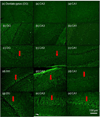Optically based-indentation technique for acute rat brain tissue slices and thin biomaterials
- PMID: 21290586
- PMCID: PMC3140429
- DOI: 10.1002/jbm.b.31789
Optically based-indentation technique for acute rat brain tissue slices and thin biomaterials
Abstract
Currently, micro-indentation testing of soft biological materials is limited in its capability to test over long time scales due to accumulated instrumental drift errors. As a result, there is a paucity of measures for mechanical properties such as the equilibrium modulus. In this study, indentation combined with optical coherence tomography (OCT) was used for mechanical testing of thin tissue slices. OCT was used to measure the surface deformation profiles after placing spherical beads onto submerged test samples. Agarose-based hydrogels at low-concentrations (w/v, 0.3-0.6%) and acute rat brain tissue slices were tested using this technique over a 30-min time window. To establish that tissue slices maintained cell viability, allowable testing times were determined by measuring neuronal death or degeneration as a function of incubation time with Fluor-Jade C (FJC) staining. Since large deformations at equilibrium were measured, displacements of surface beads were compared with finite element elastic contact simulations to predict the equilibrium modulus, μ(∞) . Values of μ(∞) for the low-concentration hydrogels ranged from 0.07 to 1.8 kPa, and μ(∞) for acute rat brain tissue slices was 0.13 ± 0.04 kPa for the cortex and 0.09 ± 0.015 kPa for the hippocampus (for Poisson ratio = 0.35). This indentation technique offers a localized, real-time, and high resolution method for long-time scale mechanical testing of very soft materials. This test method may also be adapted for viscoelasticity, for testing of different tissues and biomaterials, and for analyzing changes in internal structures with loading.
Copyright © 2011 Wiley Periodicals, Inc.
Figures











References
-
- Chen X, Sarntinoranont M. Biphasic finite element model of solute transport for direct infusion into nervous tissue. Annals of Biomedical Engineering. 2007;35:2145–2158. - PubMed
-
- Nagashima T, Tamaki N, Matsumoto S, Horwitz B, Seguchi Y. Biomechanics of Hydrocephalus: A New Theoretical Model. Neurosurgery. 1987;21:898–904. - PubMed
-
- Taylor Z, Miller K. Reassessment of brain elasticity for analysis of biomechanisms of hydrocephalus. J of Biomechanics. 2004;37:1263–1269. - PubMed
-
- Ebenstein DM, Kuo A, Rodrigo JJ, Reddi AH, Ries M, Pruitt L. A nanoindentation technique for functional evaluation of cartilage repair tissue. J. of Materials Research. 2004;19(1):273–281.
-
- Ebenstein DM, Pruitt LA. Nanoindentation of soft hydrated materials for application to vascular tissues. J. of Biomedical Materials Research Part A. 2004;69A(2):222–232. - PubMed
Publication types
MeSH terms
Substances
Grants and funding
LinkOut - more resources
Full Text Sources
Research Materials

